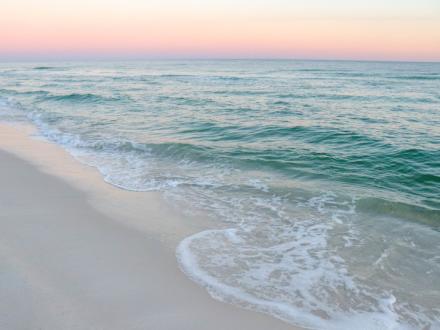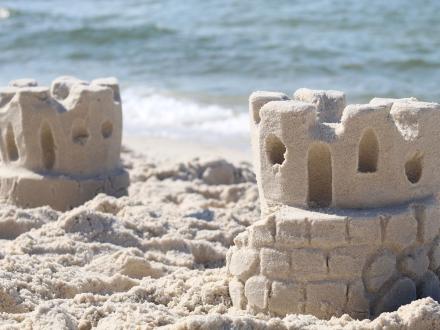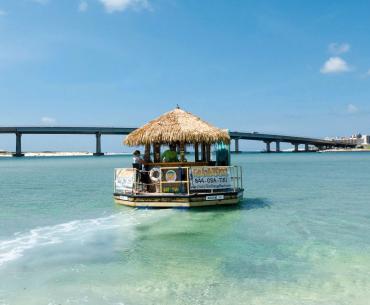
Planning a midwest road trip to Gulf Shores? Check out Theresa Goodrich's insights on all of the great stops to make on your way to the coast!
When the air smells like pumpkin spice and bonfires, Midwesterners start dreaming of taking trips to a destination with a ton of sun and sand. We love our changing seasons, but anticipating months of snow, ice, and other blistery conditions are enough to make us long for a southern getaway.
The neighboring beach towns of Gulf Shores and Orange Beach on Alabama's coast are an ideal spot for a balmy escape, and driving makes the trek itself into a vacation. If you’re thinking of your own respite to a place where shorts and flip flops replace parkas and snow boots, extend your road trip with these must-see spots highlighting history and culture.

I’m a fan of the two lanes, and US-45 is practically a straight shot from the Chicago area. A few hours south of the city, you can meet Raggedy Ann and Andy in Arcola, Illinois. Known as the entrance to Amish Country, Arcola is also the birthplace of the beloved ragdolls’ creator, Johnny Gruelle. The Historic Illinois Central Train Depot has a Raggedy Ann doll collection, and you can sit a spell with the siblings before getting back on the road.
Head to the border for Superman’s hometown of Metropolis, Illinois, and take your picture with the 12-foot-tall Man of Steel, then browse memorabilia in the Super Museum. Lois Lane is recognized with her own statue a few blocks away. This is one attraction that all DC Comic fans do not want to miss out on.
On your way back to US-45, Fort Massac State Park is a great attraction that celebrates a strategic location overlooking the Ohio River that’s been the site of several forts, built by several different countries, dating back to 1542. There’s a replica of the 1802 fort and a statue of George Rogers Clark, who landed at Massac Creek in 1778 and supposedly hoisted the first American flag in Illinois. The visitor center extends the area’s story with displays of Native American artifacts. The 1,500-acre park has a campground, and this is a perfect place to rest before continuing your journey.
Across the river, artists flock to Paducah, Kentucky. It’s one of nine UNESCO Creative Cities in the U.S. You can explore some of that creativity with a side of history with the self-guided Historic Paducah Audio Tour. Founded in 1827 by William Clark, of Lewis and Clark fame, the town is loaded with historical markers, including one honoring Martin Luther King, Jr., and another honoring the Padouca, a Native American tribe for whom Clark named his new community.
South of Jackson, Tennessee, take a detour to Pinson Mounds State Archaeological Park. This national historic landmark preserves burial and ceremonial mounds created between 100 and 300 AD. There are fifteen mounds, including the second-tallest mound in the United States. Climb to the top, and you’ll get a bird’s eye view from seventy feet up. The museum, designed to replicate a platform mound, features exhibits that tell the stories of the area before Europeans arrived, as well as the history of the site.
Inside the scenic Shiloh National Military Park, near the Mississippi border, is Shiloh Indian Mounds, which is itself a National Historic Landmark. The military park also contains a National Cemetery and Shiloh Battlefield. The battlefield memorializes the 23,000-plus casualties from the 1862 battle. There’s a self-guided audio tour, so you don’t even have to get out of the car. Additionally, there’s a museum for those seeking more information. Drive across the border to Mississippi to visit Corinth Civil War Interpretive Center, which presents the history of the Siege and Battle of Corinth.
Also in Corinth and part of Shiloh National Military Park is the Corinth Contraband Camp. A memorial for the enslaved who escaped to Union-occupied Corinth during the Civil War. It’s a small park with a big meaning. Follow the quarter-mile path to learn more about how “a newly freed people took their unswerving first steps on the long road to full citizenship.” There are several other Civil War-era sites in Corinth to visit before you get back on the road.
There are two more stops to make before getting to Gulf Shores. Architecture fans won’t want to miss the Charnley-Norwood House in Ocean Springs, Mississippi. Louis Sullivan built it for his Chicago friends, James and Helen Charnley, whom he’d randomly encountered in New Orleans. Sullivan and the Charnley’s fell in love with Ocean Springs and decided to build neighboring cottages on the Gulf of Mexico.
Fifteen minutes from this historic house is the Davis Bayou Area, one of twelve sections of the Gulf Islands National Seashore. There’s a visitor center, boat launch, hiking trails, and fishing area, as well as a popular campground. You’ll want to book your site in advance if this is part of your winter getaway.
From there, it’s time to get to those Gulf Coast, Alabama beaches. The best way is to catch the ferry from Dauphin Island, but be sure to check the schedule online as weather can cause changes or closures to the ferry. Not only will it save you time, but at $16 per vehicle, it’s also incredibly affordable. Plus, you’ll probably be flanked by pelicans along the way. The ferry disembarks at Fort Morgan Historic Site where you can see a masonry fort from the early 1800s. Used in the Civil War, the Spanish-American War, and both World Wars, the fortifications have played a vital role, especially as America’s largest permanent military post between 1900 and 1923. The museum, interpretive signs, and a self-guided audio tour bring the peninsula’s importance to life.

Next stop: Gulf Shores! You made it. While you could curl up in a cabana for the week, there are a few things you won’t want to miss, and one of them doesn’t even require leaving the beach. Sand Castle University is a fun group class that teaches you how to sculpt your own sandy masterpiece.
Start off on the beach at Alabama's renowned Gulf State Park, and then head inland to explore its nine different ecosystems. Get a good view of many of them by riding a bike through the Hugh S. Branyon Backcountry Trail. You can rent one or take advantage of the free bike-sharing program. There’s also a Segway tour for more two-wheeled wandering.
Once you’ve worked up an appetite, head to The Gulf for shrimp tacos on the beach, Lucy Buffet’s Lulu’s for amazing smoked tuna dip with a side of live music or Voyagers for a white tablecloth evening of dry-aged steak and award-winning wine.
When it’s time to head back to the Midwest, I-65 begins in Mobile, a few miles from Gulf Shores. Delay the return to the cold with an underground visit to Rickwood Caverns, or aim for the sky at the U.S. Space and Rocket Center in Huntsville, both in Alabama. Frankly, you could keep the vacation going for weeks with stops in Nashville, Mammoth Cave National Park, Louisville, and Indianapolis. Or, the next time the weather makes you shiver, just plan another road trip to the Alabama beaches.





